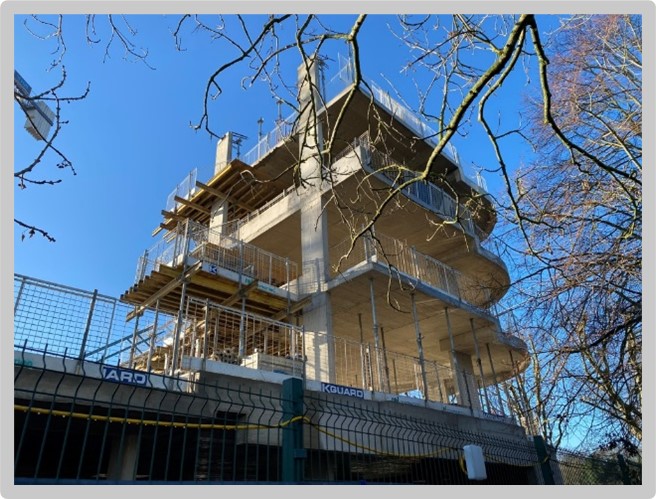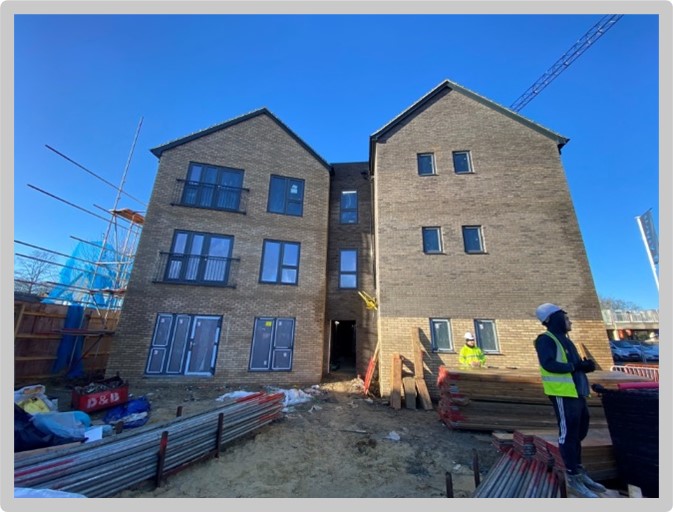This case study highlights how having a dedicated housing delivery team, fully supported by the Planning Team and members, can work in partnership to deliver above and beyond plan allocations.
Introduction
“Having that collaborative approach ensures that we are delivering for every person we can in the community. I think that's very important and that's what we want to achieve as planners”. (Local Planning Authority case officer).
- Kenilworth Close, was constructed as the first phase of the New Town development and now deemed in need of regeneration. The site comprised a former community centre (the Bragbury Centre) and two blocks of assisted living housing which were dated and past the end of their useful lives.
- The community center closed during the Covid-19 pandemic and the trustees felt unable to continue running it under those circumstances.
- The site contained large areas of greenspace between the buildings, typical to 1950s suburban development. The planning and housing teams agreed that the site could be redeveloped at a higher density than stated in the 2011-31 plan.
- Permission has been granted for 236 units across four applications (see later in this case study for more details), 229 on the Kenilworth Close site itself.
- 50% of the housing will be affordable (council) housing, and of the 50% market housing, the council will 50:50 profit-share the receipts from the market housing with the developer.
Key success factors
Planning
- Shared Vision. Officers and members shared a vision: ‘working for the common good’ -meeting the needs of vulnerable communities, people in housing need, the elderly with extra care needs; and extending the term to refer to a wider sense of social justice for current and future generations. This vision drove the development approach and choice of partners, to ensure both the successful redevelopment of the site, and the provision of high-quality affordable housing.
- Effective, early engagement including Pre-Application advice. Through early (‘pre’-pre-app) engagement, planning officers were able to ensure all statutory stakeholders (e.g., water authority, highways) made an early input and agreed on necessary measures for the proposed development to go ahead. This allowed the development to be brought on site without delays and ensure the application had adequately addressed all technical issues before it was submitted. Planners also used this time to deal with public objections and concerns, with consultations and workshops run with the architects and the housing delivery and planning teams Despite several objections at the time of application, public opinion has been more positive as the development has proceeded.
- Collaboration and discussion across the council. The key to the success in this site has been the level of collaboration between housing development, planning, (council) housing management, supported housing, parks and greenspaces, co-operative neighbourhoods, and subsequently with key private sector players.
- The overall scheme was submitted as four separate (full) planning applications. These were considered at the same time by the planning committee so that the scheme could be seen as a totality. This was important as it really helped with decision making. Potential issues on individual elements of the site could be set against the objectives of the overall scheme. This approach allows parts of the scheme to be worked on sequentially so that changes to one particular application/phase do not slow the overall development.
- Amendments to the proposals. The proposals increased the housing density dramatically (from 65 to 235). This was done by reducing the greenspace - unused large green verges (2835 sq m within the Asquith site) rather than high quality amenity space, and by the relocation of the Bragbury Community Centre. An alternative location was found for the Bragbury nearby aided by the Land Release Funding (LRF) funding. The new landscaping and design aim to make the open space more useable and beneficial for residents. This increase in density (and therefore units to be delivered on site) added to the council’s windfall housing aspirations
- The site was identified for housing in the local plan, and the previous housing stock had been designated ‘red assets’ (in a poor state of repair and not suitable for modern habitation) by housing services. -..
Site Viability
- The government’s Land Release Funding was instrumental in allowing the local authority to invest in bringing this site, and two other small sites, forward for development in a timely manner because of the financial certainty it provided. This was particularly important because of the need for new community facilities. To achieve maximum density and therefore viability on the sites, the Bragbury centre was demolished with alternative new facilities planned offsite. This also lead to an increase in community facilities within the assisted living accommodation on the Kenilworth site.
- The New Town legacy meant that the council owned most of the land, which eased site assembly and lowered potential costs. Post second world war, the Ministry of Housing and Local Government established development corporations to purchase land for the development of new towns, of which Stevenage was the first. This work was then passed on to the Commission for New Towns in 1961. In 1999 this became English Partnerships, who then passed on powers to the Homes and Communities Agency and land ownership subsequently fell to local authorities.
- Land remediation, resident re-location. The site did not face land remediation issues as much of it was ‘green’ although it was classed as previously developed land and on the brownfield register. In terms of relocating those living on the site, the existing two blocks (Asquith and Walpole) of assisted living housing were both under-occupied. This meant the council were able to temporarily rehouse those in one block while the other was demolished and whilst the new accommodation was being built.
- Strong, visible leadership. This was evident across the council. The Head of housing development and the Portfolio Holder for housing were frequently photographed together in press reporting on the site’s development.
- Creation of an in-house team. The council created a Housing Development Team to bring together individuals with the right housing and planning skills. This included bringing together skills such as site assessment, communication, negotiation and future visioning, to promote a financially viable site, rather than rely on the private sector to lead in this area.
Lessons learned
Key Lessons
- Ambition. Councils can lead development for market and affordable housing; not just attempt to steer it. In so doing, wider aspirations (high quality assisted living accommodation in this case) can be met as well and turning a profit for the local authority.
- Early Collaboration & Dialogue. Establishing this before the pre-application stage is important. Planning has a key role in leading this - between both statutory consultees, council stakeholders and members of the public. However, this needs to be underpinned by a shared vision across the council because resources are needed to support the process.
- Community engagement - small concessions can go a long way. There are some significant hurdles to overcome such as giving communities confidence about the better deployment and use of green space and play areas. And there are practical things councils can do - community reactions can be negative to any level of change but are likely to improve if you can bring communities with you during the development and small concessions, such as a temporary fish and chip shop in this case, can make a big difference to public views.
- Investment (in this case grant funding) works as an enabler to creativity by minimising risk to all parties.


